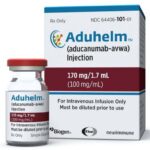What Is Aducanumab Mechanism Of Action?

Aducanumab, sold under the brand name Aduhelm, is a medication designed to treat Alzheimer’s disease, a progressive neurologic disorder that causes the brain to shrink (atrophy) and brain cells to die. Alzheimer’s disease is the most common cause of dementia, a continuous decline in thinking, behavioral and social skills that affects a person’s ability to function independently
Controversy has trailed the approval of the drugs by the US Food and Drug Administration (FDA) after an independent advisory panel fiercely questioned the new drug’s effectiveness, and researchers are divided on whether the potentially smoother approval path that aducanumab has paved will really deliver useful therapies for people with conditions such as amyotrophic lateral sclerosis (ALS), Huntington’s disease and Parkinson’s disease.
What is aducanumab mechanism of action?
Aducanumab is a recombinant human immunoglobulin gamma 1 (IgG1) monoclonal antibody directed against aggregated soluble and insoluble forms of amyloid beta, and is expressed in a Chinese hamster ovary cell line. The accumulation of amyloid beta plaques in the brain is a defining pathophysiological feature of Alzheimer’s disease. The drug reduces amyloid beta plaques, as evaluated in Studies. The effect of Aduhelm on amyloid beta plaque levels in the brain and the magnitude of reduction is time- and dose-dependent. In the long-term extension of study, a continued decrease in brain amyloid beta plaque levels was observed at Week 132 in patients.
Who should not take Aducanumab? (Contraindications)
• People who are allergic to Aducanumab
• Pregnant women
• Lactating mothers
• Children
What is the dosage of Aducanumab?
Aducanumab is available as: • Injection: 170 mg/1.7 mL (100 mg/mL) in a single-dose vial
• Injection: 300 mg/3 mL (100 mg/mL) in a single-dose vial
How should Aducanumab be taken?
It should be given as an intravenous (IV) infusion over one hour every four weeks and at least 21 days apart using a sterile, low-protein binding, 0.2 or 0.22 micron in-line filter.
After an initial titration, the recommended dosage is 10 mg/kg body weight. Diluted solution should be inspected for particles or discoloration prior to administration.
Stop the infusion upon the first observation of any signs or symptoms consistent with allergic reaction.
What are the side effects of Aducanumab?
• General: Edema, headache, Falls
• Nervous system: Confusion/Delirium/Altered Mental Status/Disorientation
What are the other precautions for Aducanumab?
Amyloid Related Imaging Abnormalities (ARIA): Increased monitoring for ARIA is recommended during the first 8 doses of treatment especially during titration.
The following reactions can occur –
• Allergies
• Angioedema
• and urticaria
What are the storage conditions for Aducanumab?
After dilution, it should be used immediately. If not administered immediately, store the diluted solution in 0.9% Sodium Chloride Injection, refrigerated at 2°C to 8°C for up to 3 days, or at room temperature up to 30°C for up to 12 hours.
Aducanumab Safety Information
Pregnancy Risk Summary
There are no adequate data on Aduhelm use in pregnant women to evaluate for a drug associated risk of major birth defects, miscarriage, or other adverse maternal or fetal outcomes. In the U.S. general population, the estimated background risk of major birth defects and miscarriage in clinically recognized pregnancies is 2 to 4% and 15 to 20%, respectively. The background risk of major birth defects and miscarriage for the indicated population is unknown.
Lactation Risk Summary
There are no data on the presence of aducanuma in human milk, the effects on the breastfed infant, or the effects of the drug on milk production. The developmental and health benefits of breastfeeding should be considered along with the mother’s clinical need for ADUHELM and any potential adverse effects on the breastfed infant from ADUHELM or from the underlying maternal condition.
Pediatric Use
Safety and effectiveness in pediatric patients have not been established.
Geriatric Use
In Studies 1 and 2, the age of patients ranged from 50 to 85 years, with a mean age of 70 years; 79% were 65 and older, and 32% were 75 and older. There were no notable differences in the incidence of adverse reactions between these age groups, and no additional safety concerns in patients 65 years of age and older compared to younger patients.




